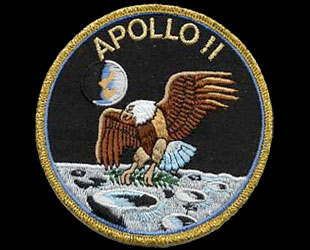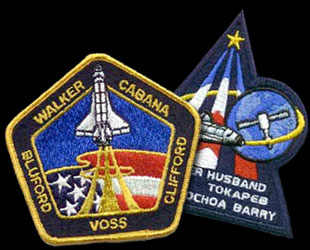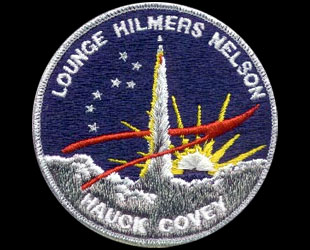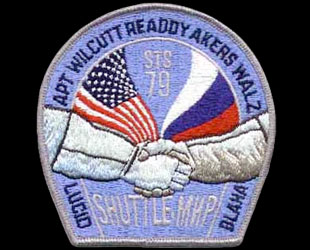Rarely do we think of an astronaut as the next Pablo Picasso or Leonardo da Vinci. Since the vast majority of the astronaut corps sprang from scientific and engineering backgrounds, we imagine them thriving more in the sciences than in the arts.
Yet every time the shuttle lifts off from Cape Canaveral, the crewmembers on board wear a unique mission patch which they themselves have designed. The creation of the mission patch represents a formidable artistic challenge: to symbolize the objectives and the character of an often-diverse crew. Such an endeavor must take into account certain social, political, and international factors and can sometimes (as art often does) even lead to controversy.
The idea of assigning a unique patch to an organized unit originated during the Civil War, when the Army of the Potomac created special insignias to identify corps and divisions. After General Robert E. Lee's surrender at Appomattox, the army dissolved and unit patches went out of fashion. The tradition was revived at the declaration of World War I and has since endured throughout all branches of the military in both war and peacetime.
Enter NASA
When NASA was founded in 1958, there was no denying its rich military heritage. The creation of NASA had been the immediate reaction of a nation that was shell-shocked by the launch of the Soviet satellite Sputnik. Desperate to save face, the United States government turned to the armed forces, frantically screening for suitable candidates for manned space flight. What resulted was the Mercury Seven: a team of steady-handed, unflinching test-pilots who brought with them both the discipline and the décor of the military. That décor included commemorative patches.
Because manned space flight was a relatively rare event (only a handful of missions per year), it was decided that patches should be created on a per-mission basis. Subsequently, every manned excursion into space has had its own corresponding mission patch: from Alan Shepard's historic flight on Mercury 3, to the space shuttle/ISS construction flights of the present day.
collectSPACE Editor's note: The author is incorrect. The first mission patch was created by Gemini 5 crewmates Gordon Cooper and Charles Conrad. Alan Shepard (and the other Mercury astronauts) did not wear, nor did they design mission patches. In fact, Cooper had to convince NASA to allow his GT-5 patch to be accepted and as such the mission emblems are sometimes referred to as "Cooper patches".
Today, over one hundred mission patches exist. With the help of NASA's Graphics Division and various merchandisers, these patch designs are marketed on trinkets such as screensavers, decals, t-shirts, coffee cups, and pendants. However, as history demonstrates, that has not always been the case...
On July 24, 1969, the Apollo 11 Lunar Excursion Module touched down at the lunar Sea of Tranquility and astronaut Neil Armstrong took "one giant leap for mankind". At the same time, roughly 240,000 miles away, a small controversy was brewing.
President John F. Kennedy's commitment to put a man on the moon before 1970 sparked a race that had pitted the resources of one vast superpower against another. With the landing of Apollo 11, NASA won that race and awakened a sense of national pride. America had beaten the Soviets to the moon, and everyone wanted a souvenir of the occasion.

That souvenir was the Apollo 11 mission patch. The patch design consisted of bald eagle, its wings outstretched, its claws grasping an olive branch as it prepared for a perfect moon landing. In a Cold-War era when Soviet communism threatened the Western world, that eagle epitomized everything American. Subsequently, the patch design became one of the most sought-after items in the space-collectibles industry, and a host of retailers strove to take advantage of Apollo fever.
Bernie Conrad, president of A-B Emblem, an emblem manufacturer and contractor to NASA, recalls the fervor.
"It was kind of goofy," said Conrad. "Everybody was making these designs. In Washington DC, there was a automobile agency that was running a promotion that if you came in to test drive one of their cars you could get an Apollo 11 patch. Some of the use of that product at that time was inappropriate."
NASA officials agreed. The Apollo 11 emblem was being used to promote everything from rock music to alcohol. Even the astronauts themselves expressed disdain and wanted the sole rights to distribute the patches. Just two days after the return of the Apollo 11 crew, NASA Administrator Thomas Paine enacted legislation making "unauthorized" possession of Apollo flight patches a federal offense. Distribution was banned immediately.
"When the heat came down, if you had stuff in inventory, you were stuck with it," recalls George W. Tiedemann, who was vice president of Space Promotions, Inc. at that time. "People were afraid to buy it. They didn't know what was going on, or who was going to do what."
The situation intensified when NASA representatives began approaching retailers directly to confront them about the new edict. Although NASA denied it, there were even unconfirmed newspaper accounts of FBI involvement.
"I can't remember them sending anybody from the FBI in to see us," recalls Conrad. "But the FBI visited customers of ours at that point and told them to cease and desist."
NASA achieved the results they desired. Before this time, mission patches were available for unrestricted use. Now, they garnered a sort of respect, similar to that of the seal of the President. As many retailers were forced out of business, the market for the Apollo insignias became increasingly restrained. By the time Apollo 12 was rocketing into the heavens, all of the investigations had come to a halt. The controversy was over, but the law remained on the books. To this day, the market for NASA insignias is closely safeguarded, but none quite as closely as the Apollo 11 patch was.
Over thirty years later, space shuttle astronauts continue to take a fierce pride in their mission patches.
"The patch is one of the first things that the crew works on together," recalls astronaut Daniel Barry. "It is not an 'individual' accomplishment. This very large team of people -- the crew, the training people, and the mission control people -- has this one badge that gives everybody a sense of working together."
Astronaut Jim Newman agrees: "The predominant goal is to symbolize the flight. Everybody tries to be unique and add their own personal touch to it."
The patch design process usually begins shortly after the crew is assigned to a mission. After an informal meeting, one member of the crew will be assigned the position of 'graphics coordinator'. Their job will be to work one-on-one with a representative from NASA's Graphics Division to communicate the ideas and desires of the crew to the technicians who will eventually construct a computer model of the patch.
Astronaut Leroy Chiao notes that the tradition of the mission patch is especially exciting for first-time fliers, who often consider their first mission patch to be a sort of status symbol. He said that they are the ones who are most likely to take on the role of 'graphics coordinator'.
"It is usually someone who is relatively new that will take the bull by the horns and get the patch going right away. With more veteran crews, after a while, somebody will finally volunteer to do it," Chiao laughs. "I guess your perspective changes after you've flown a couple of times, so it might take longer to get your patch out."

Once the crew has selected a graphics coordinator, they will begin to develop ideas for the mission patch insignia. Oftentimes, the crew will look to friends, family members, or outside organizations for inspiration. The mission patch for STS-53 was partially designed by mission specialist Rich Clifford's eight-year-old son. The final patch design for STS-96 actually evolved from a design submitted by an art student. Patches are also created for commercial satellite launches, such as those that occur at Vandenberg Air Force Base. They are often designed by the board of directors of the corporation sponsoring the launch.
One of NASA's most critical space shuttle missions occurred in 1988. STS-26 came just two years after NASA suffered the devastating loss of the Challenger disaster. It was a time when the general public and even some members of Congress viewed the space program with a mixed degree of skepticism and apprehension.
Astronaut Frederick Hauck commanded that flight and wanted the mission patch to express a new beginning for NASA. When the time came to design the patch, he turned to Stephen Hustvedt, his uncle and an accomplished artist.

"We didn't have any preconceived ideas, so I spoke with him," recalls Hauck. "He said 'well, what is the most important thing about your mission?' I said 'a safe flight'. So we drew the rocket launch representing a safe flight. We also have seven stars in a big dipper. We agreed as a crew that we wanted to include the seven stars to remind us of the seven friends killed on the Challenger. Additionally, we knew that NASA had been under this terrible loss and was working very hard to have a new beginning. What's more representative of a new beginning than a sunrise? So there is a sunrise there."
Once the crew has decided on a patch design, the designated graphics coordinator relays that design to the NASA graphics division, where a digital computer image is created. From there, it goes to NASA management for approval. After the insignia has been approved, it is sent to authorized patch/souvenir manufacturers, who create various products based on the patch design. From that point on, the patch is a permanant fixture in NASA history.
Both the collapse of communism and the birth of the International Space Station have initiated a new era. Instead of competing with each other, NASA and the Russian Aviation and Space Agency have forged a mutual alliance. This requires mission patch designers to make special international considerations when creating a patch.
For example, when plans were first drawn up to put an American astronaut on Mir, NASA decided to create a very general patch to commemorate the Shuttle/Mir program. The original design called for the patch to be surrounded by a black border. However, it was later discovered that Russian culture associates the color black with bad luck. In an effort to appease these supersitions, the black border was eventually scrubbed in favor of a gold one.

The patch design for STS-79 also sparked some controversy. Created to symbolize the first shuttle/Mir docking, the original artist's sketch depicted a Russian and an American astronaut shaking hands, the Russian flag on the left and the American flag on the right. To the artist, it seemed to be a harmless display of cooperation, but NASA management struck down this design. It was decided that in a show of patriotism, the American flag would always fly above or to the left of the Russian flag on all NASA emblems. The patch was redesigned accordingly.
It is expected that NASA and the Russian space agency will continue to be partners for a long time to come. This will create new cultural challenges as patch designers strive to paint the future in a canvas of thread...
Travis K. Kircher is a freelance writer based in Louisville, Kentucky. He can be reached at [email protected].